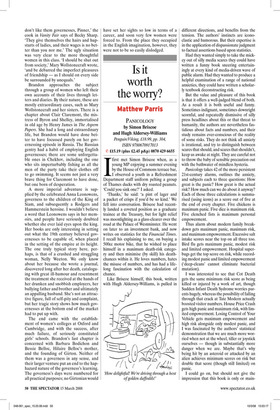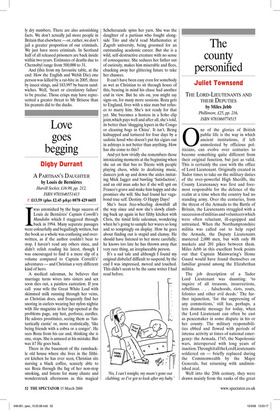Is it worth the worry?
Matthew Parris
PANICOLOGY by Simon Briscoe and Hugh Aldersey-Williams Penguin/Viking, £18.99, pp. 304, ISBN 9780670917013 ✆ £15.19 (plus £2.45 p&p) 0870 429 6655 Ifirst met Simon Briscoe when, as a young MP enjoying a summer evening by the House of Commons terrace bar, I observed a youth in a Refreshment Department staff uniform pelting a group of Thames ducks with dry roasted peanuts. ‘Could you sink one?’ I asked.
‘Thanks,’ he said: ‘a pint of lager and a packet of crisps if you’d be so kind.’ We fell into conversation. Briscoe had recently landed a coveted position as a graduate trainee at the Treasury, but for light relief was moonlighting as a glass-clearer over the road at the Palace of Westminster. He went on later to an investment bank, and now writes on statistics for the Financial Times. I recall his explaining to me, on buying a 500cc motor bike, that he wished to place himself in a maximum death-risk category and then minimise (by skill) his deathchances within it. He loves numbers, hates the misuse of numbers, and has had a lifelong fascination with the calculation of chance.
Like Briscoe himself, this book, written with Hugh Aldersey-Williams, is pulled in different directions, and benefits from the tension. The authors’ instincts are iconoclastic and humorous. But their expertise is in the application of dispassionate judgment to factual assertions based upon statistics.
Had they wanted simply to take the mickey out of silly media scares they could have written a funny book sneering entertainingly at every kind of media-driven wave of public alarm. Had they wanted to produce a helpful examination of a range of national anxieties, they could have written a scholarly textbook deconstructing risk.
But the value and pleasure of this book is that it offers a well-judged blend of both. As a result it is both useful and funny. Sometimes indignant, sometimes downright scornful, and repeatedly dismissive of silly press headlines about this or that threat to humanity, the authors are nevertheless fastidious about facts and numbers, and their study remains ever-conscious of the reality of some risks. They do not think all anxiety is irrational, and try to distinguish between scares that should, and scares that shouldn’t, keep us awake at night. They are careful not to throw the baby of sensible precaution out with the bathwater of mindless hysteria.
Panicology takes 42 of the more persistent 21st-century alarms, outlines the anxiety, and subjects each to three questions: How great is the panic? How great is the actual risk? How much can we do about it anyway? Each of those three calculations is summarised (using icons) as a score out of five at the end of every chapter. Five chickens is maximum panic. Five dice is maximum risk. Five clenched fists is maximum personal empowerment.
Thus alarm about modern family breakdown gets maximum panic, maximum risk, and maximum empowerment. Excessive salt intake scores near the top on all three too. Bird flu gets maximum panic, modest risk and limited empowerment. Hospital superbugs get the top score on risk, while recording modest panic and limited empowerment (‘deep-cleans’ cannot eliminate bacterial mutation).
I was interested to see that Cot Death gets the same minimum risk score as being killed or injured by a work of art, though Sudden Infant Death Sydrome worries parents hugely, whereas the possibility of falling through that crack at Tate Modern actually boosted visitor numbers. House Price Crash gets high panic and maximum risk, with limited empowerment. Losing Control of Your Vehicle gets maximum empowerment and high risk alongside only modest panic, and I was fascinated by the authors’ statistical demonstration that we are much more worried when not at the wheel, tiller or joystick ourselves — though in substantially more danger when we are. Maybe that’s why being hit by an asteroid or attacked by an alien achieves minimum scores on risk but double that score (though still limited) on panic.
I could go on, but should not give the impression that this book is only or main ly dry numbers. There are also astonishing facts. We don’t actually jail more people in Britain that elsewhere — or, rather, we don’t jail a greater proportion of our criminals. We just have more criminals. In Scotland half of all released prisoners are back inside within two years. Estimates of deaths due to Chernobyl range from 500,000 to 31.
And (this from my favourite table, at the end: How the English and Welsh Die) one person was killed by a rat-bite in 2005, three by insect stings, and 183,997 by bacon sandwiches. Well, ‘heart or circulatory failure’ to be precise. Those crisps may have represented a greater threat to Mr Briscoe than his peanuts did to the ducks.



























































































 Previous page
Previous page